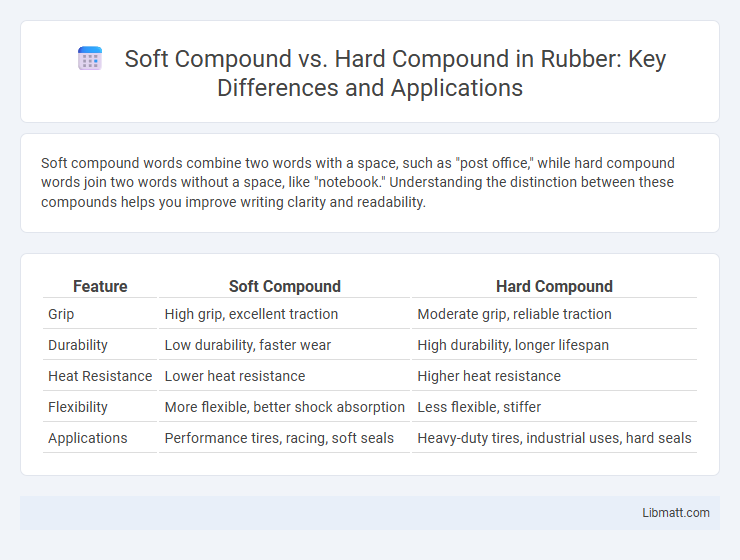Soft compound words combine two words with a space, such as "post office," while hard compound words join two words without a space, like "notebook." Understanding the distinction between these compounds helps you improve writing clarity and readability.
Table of Comparison
| Feature | Soft Compound | Hard Compound |
|---|---|---|
| Grip | High grip, excellent traction | Moderate grip, reliable traction |
| Durability | Low durability, faster wear | High durability, longer lifespan |
| Heat Resistance | Lower heat resistance | Higher heat resistance |
| Flexibility | More flexible, better shock absorption | Less flexible, stiffer |
| Applications | Performance tires, racing, soft seals | Heavy-duty tires, industrial uses, hard seals |
Introduction to Tire Compounds
Tire compounds determine grip, durability, and performance characteristics by varying the rubber formulation between soft and hard types. Soft compounds provide enhanced traction and better handling at the cost of faster wear, making them ideal for short, high-speed use or racing conditions. Your choice between soft and hard compounds affects tire lifespan and driving experience, balancing performance needs with long-term durability.
What is a Soft Compound?
A soft compound tire is designed with a pliable rubber formulation that enhances grip and traction on track surfaces, especially in cooler temperatures. This type of compound provides superior performance through increased friction and quicker heat absorption, allowing your vehicle to corner more effectively and brake with precision. Soft compounds generally wear faster but deliver optimal lap times, making them ideal for short stints in racing conditions.
What is a Hard Compound?
A hard compound is a type of keyboard keycap made from dense, rigid materials like ABS or PBT plastic, offering durability and a firm typing feel. These keycaps resist wear and shine over time, maintaining texture even with heavy use. Hard compounds provide precise tactile feedback favored by gamers and typists seeking performance and longevity.
Key Differences Between Soft and Hard Compounds
Soft compounds offer superior grip and traction by using softer rubber that conforms closely to the road surface, making them ideal for wet or slippery conditions. Hard compounds provide enhanced durability and longer wear life due to their firmer rubber composition, which resists abrasion and heat build-up better on dry, rough surfaces. Choosing the right compound for your tires depends on your driving style and conditions, balancing performance with longevity.
Performance Impact on Grip and Handling
Soft compound tires provide superior grip and enhanced handling due to their increased flexibility and better road adherence, making them ideal for sharp cornering and quick acceleration. Hard compound tires, while offering reduced grip, excel in durability and consistency over longer distances, resulting in more stable handling under sustained loads. Your choice between soft and hard compounds directly influences vehicle performance, balancing traction needs against tire longevity.
Durability and Wear Comparison
Soft compounds offer superior grip and traction but tend to wear out faster, making them less durable under prolonged use. Hard compounds provide enhanced durability and better resistance to wear, especially on abrasive surfaces, though they sacrifice some grip and performance. Your choice depends on balancing the need for longevity against the desired level of traction for specific conditions.
Optimal Usage Scenarios for Each Compound
Soft compounds provide superior grip and traction on wet or rough surfaces, making them ideal for racing on slippery tracks or in rainy conditions. Hard compounds excel in durability and wear resistance, suitable for long-distance races or high-speed circuits where tire longevity is critical. Choosing the right compound ensures your vehicle maintains optimal performance, balancing grip and tire life based on the track conditions and race duration.
Influence on Racing and Everyday Driving
Soft compounds enhance racing performance by providing superior grip and faster lap times due to their increased traction and heat absorption, though they wear out quickly under extended use. Hard compounds offer greater durability and consistent performance for everyday driving, prioritizing long tread life and fuel efficiency while sacrificing some grip and cornering ability. The choice between these compounds directly impacts vehicle handling, tire longevity, and overall driving experience in both racing and daily road conditions.
Factors to Consider When Choosing Tire Compounds
Selecting between soft compound and hard compound tires depends on factors such as track temperature, tire durability, and grip requirements. Soft compounds offer superior traction and quicker heat-up times but wear out faster, making them ideal for shorter, high-performance runs. Assessing your racing conditions and endurance needs ensures you choose the tire compound that balances performance and longevity for your vehicle.
Conclusion: Choosing the Right Compound for Your Needs
Soft compounds offer superior grip and enhanced traction, making them ideal for short, high-performance use or wet conditions, but they wear out quickly. Hard compounds provide longer durability and better heat resistance, fitting for extended mileage and dry surfaces without frequent replacements. Your choice depends on balancing performance needs with tire longevity for optimal results.
Soft Compound vs Hard Compound Infographic

 libmatt.com
libmatt.com